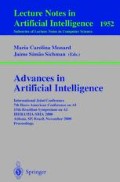Abstract
This paper describes a hybrid method for supervised training of multivariate regression systems that can be an alternative to other methods. The proposed methodology relies on supervised clustering with genetic algorithms and local learning. Genetic A lgorithm d riven C lustering (GAdC) offers certain advantages related to robustness, generalization performance, feature selection, explanative behavior and the additional flexibility of defining the error function and the regularization constraints. In this contribution we present the use of GAdC for toxicity prediction of pesticides. Different molecular descriptors are computed and the correlation behavior of the different descriptors in the descriptor space is studied. Decreasing the number of descriptors leads to a faster and more accurate model.
Access this chapter
Tax calculation will be finalised at checkout
Purchases are for personal use only
Preview
Unable to display preview. Download preview PDF.
References
S. M. Green, and G. R. Marshall (1995). 3D-Qsar — A Current Perspective, Trends In Pharmacological Sciences, 16, 285.
D. Devogelaere, P. Van Bael, and M. Rijckaert (1999). Regression Through Genetic Algorithm driven Clustering, Proceedings of the 1999 European Conference on Intelligent Techniques and Soft Computing (EUFIT), September 7–10, Aachen, Germany.
C. G. Atkeson, A. W. Moore, and S. Schaal (1997). Locally Weighted Learning, Artificial Intelligence Review, Vol.11, 11–73.
L. Torgo (1999). Predicting the Density of Algae Communities using Local Regression Trees, Proceedings of the 1999 European Conference on Intelligent Techniques and Soft Computing (EUFIT), September 7–10, Aachen, Germany.
P. R. Krishnaiah, and L. N. Kanal (1982). Classification, Pattern Recognition, and Reduction of Dimensionality, Volume 2 of handbook of Statistics. North-Holland, Amsterdam.
L. I. Kuncheva, and J. C. Bezdek (1998). Nearest Prototype Classification: Clustering, Genetic Algorithms or Random Search?, IEEE Transactions on Systems, Man, and Cybernetics, 160–164.
Z. Michalewicz (1996). Genetic Algorithms + Data Structures = Evolution Programs (3rd.Ed). Berlin, Springer-Verlag.
H. Schwefel (1994). Evolution and Optimum Seeking, New York, John Wiley & Sons.
E. Benfenati, S. Pelagatti, P. Grasso, and G. Gini. COMET (1999), Predictive Toxicology of Chemicals: Experiences and Impact of AI Tools, AAAI 1999 Spring Symposium Series; AAAI Press, Menlo Park, CA, 40–43.
L. A. Ludwig, F. Berk, and A. Grauel (1999). Predictive Toxicology with optimized neural networks, Proceedings of the 1999 European Conference on Intelligent Techniques and Soft Computing (EUFIT), September 7–10, Aachen, Germany.
S. C. Basak et al. (1999). Use of Statistical and Neural Net Methods in Predicting Toxicity of Chemicals: A Hierarchical QSAR Approach, Proceedings of the American Association for Artificial Intelligence Spring Symposium Series, March 22–24, Stanford University (CA), USA.
Author information
Authors and Affiliations
Editor information
Editors and Affiliations
Rights and permissions
Copyright information
© 2000 Springer-Verlag Berlin Heidelberg
About this paper
Cite this paper
Devogelaere, D., Van Bael, P., Rijckaert, M. (2000). A Soft Computing Approach for Toxicity Prediction. In: Monard, M.C., Sichman, J.S. (eds) Advances in Artificial Intelligence. IBERAMIA SBIA 2000 2000. Lecture Notes in Computer Science(), vol 1952. Springer, Berlin, Heidelberg. https://doi.org/10.1007/3-540-44399-1_45
Download citation
DOI: https://doi.org/10.1007/3-540-44399-1_45
Publisher Name: Springer, Berlin, Heidelberg
Print ISBN: 978-3-540-41276-2
Online ISBN: 978-3-540-44399-5
eBook Packages: Springer Book Archive

